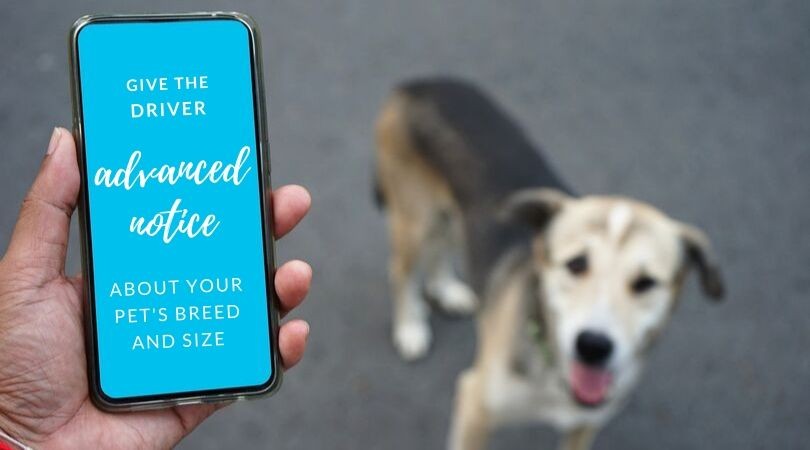Traveling with your furry friend is becoming increasingly common, and for pet owners who rely on ridesharing services like Uber, a crucial question arises: “Are Pets Allowed On Uber?” As more people opt for ride-sharing over personal car ownership, understanding pet policies for transportation is essential. Whether you’re heading to a dog-friendly park, a grooming appointment, or even an emergency vet visit, navigating pet travel options is key. Let’s explore the ins and outs of bringing your pet along for an Uber ride.
Uber Pet Policy: The Basics
Understanding Uber’s pet policy is the first step in planning your journey with your animal companion. It’s important to distinguish between service animals and other pets, as the rules differ significantly.
Service Animals: Always Welcome
According to Uber’s guidelines and the Americans with Disabilities Act (ADA), service animals are always permitted in Uber vehicles. The ADA clearly defines a service animal as a dog individually trained to perform tasks for a person with a disability. This includes physical, sensory, psychiatric, intellectual, or other mental disabilities. Uber drivers are legally obligated to accommodate service animals, regardless of any personal “no pets” preferences or general pet policies. Denying transportation to a person with a service animal is a violation of these regulations. Keep in mind this legally protected access applies specifically to dogs trained as service animals.
Non-Service Animals: Driver Discretion
For pets that are not service animals, including emotional support animals and general pets like cats or smaller animals, the policy is less definitive. Uber’s general pet policy leaves the decision to individual drivers. Unless legally required to accept service animals, Uber drivers have the autonomy to decide whether or not to allow pets in their vehicles. This means that taking your dog, cat, or other pet on an Uber ride is not guaranteed and depends entirely on the driver’s willingness.
 Dog owner looking at smartphone screen
Dog owner looking at smartphone screen
How to Increase Your Chances of Riding Uber with Your Pet
While Uber drivers have the final say, there are several proactive steps you can take to increase the likelihood of a driver accepting your pet and ensuring a smooth, positive experience for everyone involved.
Advanced Notice & Communication is Key
One of the most effective strategies is to communicate with your driver as soon as possible. Upon requesting your Uber, utilize the app’s messaging or calling feature to inform the driver that you are traveling with a pet. Providing details about your pet, such as breed and size, can also be helpful. This advance notice allows the driver to prepare or decide if their vehicle is suitable for accommodating your pet comfortably and safely. Honest and upfront communication sets a positive tone and allows for mutual respect and understanding from the outset.
Pet Preparation Before the Ride
Preparing your pet before the Uber arrives is not only courteous but also practical. Take your dog for a walk before the ride. This provides an opportunity for them to relieve themselves, reducing the chances of accidents inside the vehicle. Exercise also helps expend some of your pet’s energy, making them calmer and more likely to settle down during the ride. A relaxed pet contributes to a more pleasant experience for both the driver and yourself.
Protect the Vehicle: Bring Supplies
Drivers are understandably concerned about keeping their vehicles clean and in good condition. Shedding, accidents, or muddy paws are potential issues when transporting pets. To mitigate these concerns and show consideration for the driver’s vehicle, come prepared. Bring a blanket, sheet, or pet carrier. Placing a blanket or sheet on the seat where your pet will sit offers a protective layer against hair, dirt, and potential accidents. For smaller pets, using a carrier is an excellent way to contain them securely and minimize any mess. Informing the driver that you have taken these protective measures can significantly increase their willingness to accept your pet.
Show Your Appreciation: Tip and Review
If a driver kindly agrees to transport you and your pet, expressing your gratitude is important. A tangible way to show appreciation is by offering a more generous tip than you typically would. In addition to a tip, leaving a positive review for the driver is incredibly valuable. Uber and Lyft drivers rely on positive ratings and reviews. Mentioning their pet-friendly service in your review can also be helpful for other pet owners looking for reliable transportation. Positive reinforcement encourages drivers to be more open to accepting pets in the future, creating a more pet-friendly rideshare environment.
What About Other Rideshares Like Lyft?
While this article focuses on Uber, it’s worth noting that Lyft’s pet policy is very similar. Lyft also mandates the acceptance of service animals but leaves the decision regarding other pets to the driver’s discretion. The same tips and best practices discussed for Uber generally apply to Lyft as well. Communicating with your driver, preparing your pet, protecting the vehicle, and showing appreciation are all effective strategies regardless of the rideshare service you choose.
Pets on Public Transportation: A Quick Look
While the focus here is on rideshares, it’s helpful to briefly touch upon public transportation. Policies for pets on buses, trains, and subways vary significantly depending on the city and transportation system.
Unlike the somewhat standardized approach of Uber and Lyft regarding service animals, public transit pet policies are much more localized. Some systems, like Amtrak (for trains), have specific pet policies with restrictions like limited pet spaces per train and associated fees. New York City’s public transport requires pets to be in containers. San Francisco allows leashed and muzzled dogs on cable cars, buses, and subways.
The key takeaway for public transportation is to always check the specific pet policy of the transit system you plan to use in advance. Policies can cover carrier requirements, leash rules, muzzles, and sometimes even require health documentation. Familiarizing yourself with these rules beforehand prevents unexpected issues and ensures compliance.
Essential Tips for a Smooth Ride with Your Pet (Regardless of Transport)
Beyond Uber-specific strategies, some general best practices apply to any form of pet travel, be it rideshares or public transportation.
Socialization is Paramount
Ensure your pet is well-socialized and comfortable around strangers, both humans and other animals. A nervous or reactive pet can become stressed and potentially disruptive in an enclosed public space. Socialization training helps your pet remain calm and well-behaved in unfamiliar environments, making travel less stressful for them and more pleasant for everyone around.
Carry Necessary Health Records
While not always explicitly required, carrying proof of your pet’s up-to-date vaccinations and health records is a prudent step. In certain situations, especially on public transportation or if any issues arise, having this documentation readily available can be helpful. It demonstrates responsible pet ownership and can prevent potential complications.
Policy Research: Always Do Your Homework
We’ve emphasized this point, but it bears repeating: always research the specific pet policy of the transportation service you intend to use. Whether it’s Uber, Lyft, a local bus, or a train line, policies vary. Checking beforehand ensures you are fully informed about any requirements, restrictions, or fees associated with traveling with your pet.
Pack Calming Aids: Treats and Comfort Items
Finally, consider bringing items that help keep your pet calm and comfortable during the journey. Favorite treats can be a great distraction and reward for good behavior. A familiar blanket or toy can provide a sense of security and comfort in a new environment. These small touches can make a significant difference in your pet’s travel experience, contributing to a smoother, more enjoyable ride for both of you.
Make Your Pet’s Ride Rewarding
Traveling with your pet via Uber or other transportation methods doesn’t have to be stressful. With a little preparation, clear communication, and consideration for drivers and policies, you can ensure positive and successful journeys with your beloved animal companion. By being proactive and informed, you and your pet can navigate the world of rideshares and public transport with confidence and ease.
